#Carson national forest
Text

#nature#mountains#hiking#landscape#new mexico#forest#lake#trampas#trampas lakes#sangre de cristo mountains#Sangre de cristos#pecos wilderness#Carson national forest
85 notes
·
View notes
Text
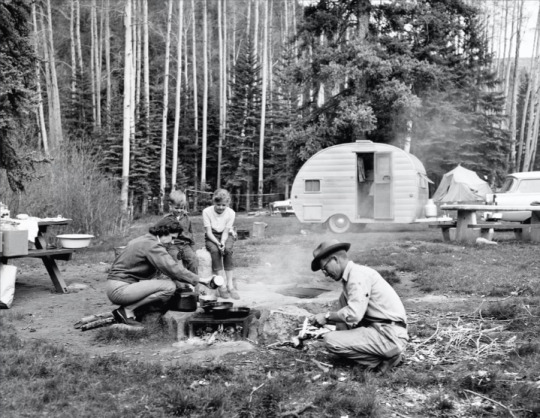
Lunch is on the griddle at the Santa Barbara Forest Camp.
Carson National Forest, New Mexico
1959
#vintage camping#campfire light#carson national forest#new mexico#santa barbara forest#family#camping
193 notes
·
View notes
Text
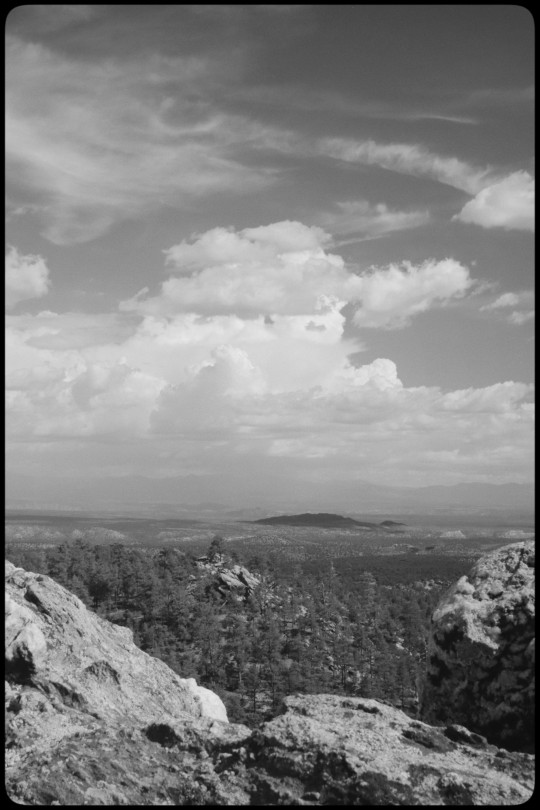
Facing south from the Sunnyside Mine
#new mexico#carson national forest#photographers on tumblr#black and white#lensblr#nature photography#landscape photography
7 notes
·
View notes
Text
Williams Lake 11,040 feet
Carson National Forest
Taos, NM
October 2023
#New Mexico#alpine lake#Taos#Carson national forest#gray Jay#mountains#October#photo#landscape#southwest#nature#wheeler peak
0 notes
Text
Forestry partners lay out reasons to continue prescribed burns
Forestry partners lay out reasons to continue prescribed burns
By KAY MATTHEWS
I recently spoke with two northern New Mexicans involved in critical forest restoration projects about the fallout over prescribed burning as a restoration tool after the Hermits Peak and Calf Canyon Fire burned over 370,000 acres of forests, homes, fields, and acequias. Matt Piccarello is the New Mexico Forest Watershed and Health Manager for The Nature Conservancy (TNC), and…
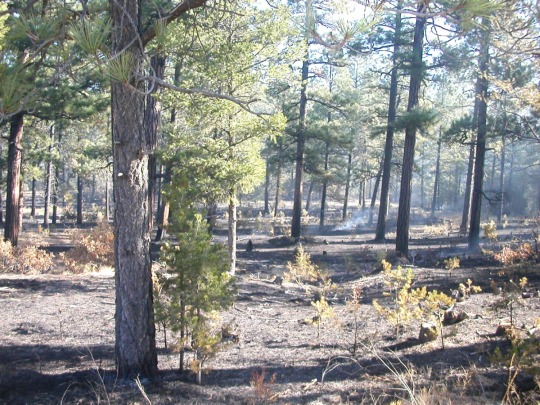
View On WordPress
#Carson National Forest Supervisor James Duran#Cerro Negro Forest Council#Forest Stewards Guild#Greater Santa Fe Fireshed#Hermits Peak and Calf Canyon Fire#J.R. Logan#Matt Piccarello#Pueblo of Tesuque#Rio de las Trampas Forest Council#Rio Grande Water Fund#Santa Fe Mountains Landscape Resiliency Project (SFMLRP)#The Nature Conservancy
0 notes
Text

In 1946, Argentina introduced twenty beavers (Castor canadensis) to Tierra del Fuego (TdF) to promote the fur industry in a land deemed empty and sterile.
Beavers were brought from Canada by Tom Lamb, [...] known as Mr. North for having expanded the national frontier [...]. In the 1980s, local scientists [...] found that beavers were the main disturbers of sub-Antarctic forests. The fur industry had never been implemented in TdF and [...] beavers had expanded, crossed to Chile, and occupied most of the river streams. The Beavercene resulted in apocalyptic landscapes [...]: modified rivers, flooded lands, and dead native trees that, unlike the Canadian ones, are not resilient to flooding. [...]
At the end of the nineteenth century the state donated lands to Europeans who, in building their farms, also displaced and assassinated the indigenous inhabitants of TdF. With the settlers, livestock and plants also invaded the region, an “ecological imperialism” that displaced native populations. In doing this, eugenic and racializing knowledges mediated the human and nonhuman population politics of TdF.
---
In the 1940s, the Argentinian State nationalized these settlers’ capitals by redistributing their lands. [...] In 1946, the president of the rural association in TdF opened the yearly livestock [conference]: We, settlers and farmers of TdF have lived the evolution of this territory from the times of an absent State. [...] [T]hey allied with their introduced animals, like the Patagonian sheep or the Fuegian beaver. At a time when, after the two world wars, the category of race had become [somewhat] scientifically delegitimized, the enhancement and industrialization of animals enabled the continuation of racializing politics.
In 1946, during the same livestock ceremony in TdF, the military government claimed:
This ceremony represents the patria; it spreads the purification of our races … It is our desire to produce an even more purified and refined race to, directly, achieve the aggrandizement of Argentina.
---
The increasing entanglement between animal breeding and the nation helped to continue the underlying Darwinist logic embedded in population politics. Previous explicit desires to whiten the Argentinian race started to be actualized in other terms. [...]
Settlers had not only legitimated their belonging to TdF by othering the indigenous [people], [...] but also through the idea that indigenous communities had gone extinct after genocide and disease. At that time, the “myth of extinction” helped in the construction of a uniform nation based on erasing difference, as a geography textbook for school students, Historia y Geografía Argentinas, explained in 1952: If in 1852 there were 900,000 inhabitants divided in 90,000 whites, 585,000 mestizos, 90,000 [Indigenous people] and 135,000 [...] Black, a century later there was a 90% of white population out of 18,000,000 inhabitants. (357) [...] [S]tate statistics contributed to the erasure of non-white peoples through the magic of numbers: it is not that they had disappeared, but that they had been statistically exceeded [...]. However, repressed communities never fully disappear.
---
Text by: Mara Dicenta. "The Beavercene: Eradication and Settler-Colonialism in Tierra del Fuego". Environment & Society Portal, Arcadia (Spring 2020), no. 1. Rachel Carson Center for Environment and Society. [Image by Mara Dicenta, included in original article. Bold emphasis and some paragraph breaks/contractions added by me.]
293 notes
·
View notes
Text

here's the drawing for the Pegasus Natives AU!!!! im so proud of it like the FOLDS the SHADING omg im so excited to share this with you
fashion breakdown under the cut bc i way overthought this lol
from left to right
aiden - i tried to have my references match the vibe of canon for the planet with all the kids but the most important additions imo were his flat cap and his "shoes". the flat cap was because ford wore that ballcap of his so often he looked weird without it, and i once again felt it matched the vibe. the barefoot covers were based off acrobat covers because i refuse to believe that feral forest children who climbed trees for a living wore real shoes.
teyla - i felt like taking one of her canon outfits was cheating in a way??? so when i saw a sweater shawl in my references it screamed teyla to me. the satchel belt was embarrassingly an afterthought when i realised she was the only one without any pockets 😅
elizabeth - i pulled the colours from her usual outfits and uniform because she looks so good in red 😍
john - this was really hard! and also the only one where my references were screencaps from canon. i mixed Ronan's tunic shirt, holsters, and blaster with John's cloister outfit from epiphany
rodney - we really only see the genii in either uniform or farm garb, but i know there has to be a secret third fashion. because the technology mirrors 1940s allied nations, i went with 1940s men's fashion. his tie is pulled from his uniform patch
radek - same as rodney but i went with a different reference lol but his sweater is pulled from the uniform undershirt he always wears
carson - hoffans seem to wear a lot of 1918 three piece suits, so i took inspo from a bunch of different suits to get one i really liked. his undershirt is the same powder blue as the shirt he wears under his uniform (bc i wasnt liking the yellow of his uniform patches 😅)
#pegasus natives au#pn:au#mushroom art#stargate#stargate atlantis#teyla emmagan#elizabeth weir#aiden ford#john sheppard#rodney mckay#radek zelenka#carson beckett
18 notes
·
View notes
Text
Confluence of Comanche Creek and Rio Costilla in the Valle Vidal unit of the Carson National Forest. Nice oxbow. The rock formation is known as Comanche Point.
#New Mexico#NewMexico#vacation#roadtrip#travel#daytrip#weekendgetaway#nature#OptOutside#offthebeatenpath#water#landscape#new mexico landscape#new mexico skies
25 notes
·
View notes
Note
If you ever wanted to share some of those feelings about prem teams and poor roster management, I would love to hear about it! I'm still very much in learning mode and love to know people's thoughts :D
Oh all the time!! I'm going to put this under the cut because this is going to be a long one gang! (This is also going to target Man City a bit, and Nottingham Forest, and Chelsea a bit as they are the current examples I could think of so ... sorry guys)
Introduction - Premier League Squad Rules
So in general the Premier League squad rules are that you can name a 25 man squad to play in the Premier League that season. Only 17 of those players can be not "home-grown" and under 21s are not included in this list.
A "home-grown" player is a player who, irrespective of nationality or age, has been registered with any club affiliated to The Football Association or the Football Association of Wales for a period, continuous or not, of three entire seasons, or 36 months, before his 21st birthday.
So these rulings massively encourage teams to sign very talented Under-21s to their academies (ideally under 18s) so that they can play them if needed and keep them so they class as home-grown when they get older.
Point 1 - Homegrown Players
Therefore, what a lot of rich title challenging prem teams do is they find reliable, would be fine in the team but not exceptional, cheap homegrown players to fill those slots and make use of that 'extra' space. For example Man City have a third choice keeper Scott Carson who (credit to him) has the most lush job imaginable. He plays like 10 minutes a year or maybe a few matches in lesser trophies but because he is a homegrown player they might as well have him on the squad list instead of an international third choice keeper who would take up one of the valuable spots. So if you have no intention of playing a player except for in dire, there is truly no one else situations then get a homegrown player from a smaller team for cheap.
But! What this does mean is it can really hamper the careers of these homegrown players because the club has no intention of playing them (often the managers don't even really like them or play a formation that suits them), they are just there because you might as well. An example of this is Kalvin Phillips at Man City. Now by now a lot of people on here know how much of a fan of Kalvin I am (he is a wonderful human being, excellent defensive mid and all round sweet guy), but even that aside he does not play more than 15 minutes in a match for Man City because there is no space for him. He is used to rest players when matches are already won and that's it really. The only position he could fill is filled by Rodri and if Rodri can't play then Pep changes the whole formation. SO he is only there for dire emergencies. But he is an England player, he is national standard and despite all the medals, the lack of squad rotation is harming his career in a massive way.
So the home-grown player rule is great to improve development of English players but it encourages teams to sign players they don't really want or need because there are spots to fill.
Point 2 - If you want him then I'll have him
(This is particularly the case with under-21s)
With clubs being bought by oil money now, this leads to a "throw money at the situation approach" which means that as soon as a player is highly rated then lots of clubs jump at the chance to buy that player whether that is actually a player they need or fits in their scheme. If this player is under 21 then it's better because they don't fit into the 25 man squad. For example this summer transfer window Chelsea signed 12 players. Three of them were defensive midfielders ... a position that AT MOST you play 2 of at once. And they already had three! This panic of "oh no, this team want this player so he must be better than what I've already got" leads again to teams getting players that don't improve the team and/or are surplus to requirements. But you can't throw your multimillion dollar signing who you have very publicly signed to the wayside! So they have to play no matter what because so much effort and money has gone into their signing. You can't bench someone who cost £100m for an academy player or you will be torn to shreds even if it might be better for a team to rest their star or if god forbid he ain't performing, it is so difficult for the manager for the manager to make changes.
Point 3 - Win at all costs!
So, being part of a Premier League side means congested fixtures. You might have European competition, you might have FA Cup, you might have World Club Cup, you might have League Cup. So this means playing a lot of football! You might think "Candle, contrary to your argument here this sounds like a great opportunity to rotate in players so that people don't get tired or injured?" WRONG! Particularly in mid table clubs, cups are their best chance to win trophies. If you want to win trophies you play your starters to not risk an upset. But then you need to play your starters in the league because league performance is the most important thing for Euro qualification or to avoid relegation. Big clubs also don't want the shame of being victim to a giant killing so may play starters against lower league sides to avoid that. If you are worried about your league position and lose to Arsenal in the cup, fine. If you are worried about your league position and lose to Forest Green Rovers in the cup, you are a disgrace and an embarrassment to the sport. Therefore encourages lack of rotation because you are more likely to win if your best players are out there.
Point 4 - Attention Span of a Goldfish
The fans are to blame for this ... sorry fans. If you rotate in a player, and that player has a bad game or is lacking match fitness then managers get torn to shreds in the media, by the fans and the board of their club. So that player gets benched again, even if it was a blip or against a superior side. If a player is playing well and is benched for rest and then the team loses then managers get torn to shreds in the media, by the fans and the board of their club. The culture doesn't encourage looking after the players and maybe accepting that there might be some iffy performances for a player to get settled into the side or slightly less impressive performances from fringe players. For example Darwin "Captain Chaos" Nunez for Liverpool. When he first came to Liverpool he was god awful, couldn't even hit the stands when he shot, got the nickname Captain Chaos because no one knew what he was doing. He kept being benched, because he wasn't doing what the club wanted but all that did was knock his confidence and mean that it was a lot harder to rotate strikers.
Point 5 - Favourite Children
Simple point, most managers have players that they just ... like and others that they don't. Managers are human. You are more likely to pick a player that you like to start than one that might irritate you or you didn't really want on your team EVEN IF it is to the benefit of your favourite child to rest them.
TLDR - Premier League clubs (particularly those at the top of the table) are awful at reducing burnout and injury in their players through rotation. This is partially through team design, external pressures, stupid signings, cost of players, and favouritism. It is bizarre that the teams that have the best depth in squads are the most reluctant to use it
19 notes
·
View notes
Text
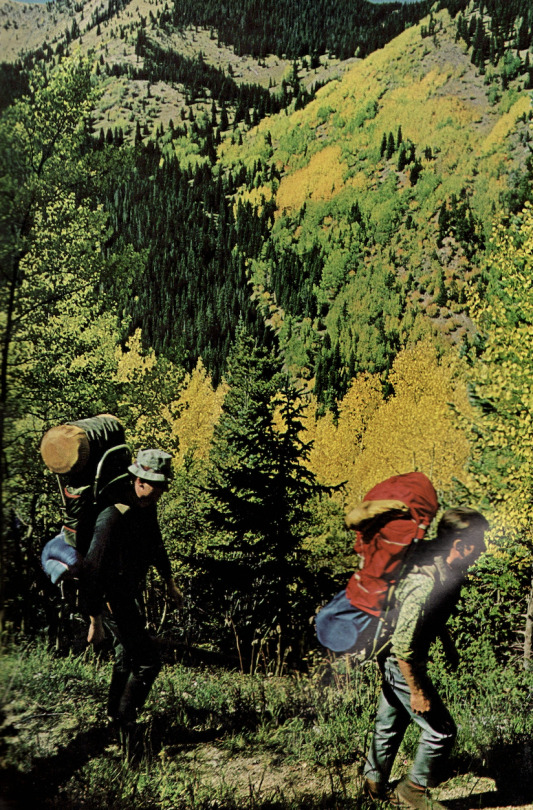
Backpackers head for Wheeler Peak in Carson Forest, New Mexico
National Geographic - September, 1970
18 notes
·
View notes
Photo




One with Nature: Connecting with the Natural World
Losing Eden: Why Our Minds Need the Wild by Lucy Jones
Today many of us live indoor lives, disconnected from the natural world as never before. And yet nature remains deeply ingrained in our language, culture and consciousness. For centuries, we have acted on an intuitive sense that we need communion with the wild to feel well. Now, in the moment of our great migration away from the rest of nature, more and more scientific evidence is emerging to confirm its place at the heart of our psychological wellbeing. So what happens, asks acclaimed journalist Lucy Jones, as we lose our bond with the natural world--might we also be losing part of ourselves?
Delicately observed and rigorously researched, Losing Eden is an enthralling journey through this new research, exploring how and why connecting with the living world can so drastically affect our health. Travelling from forest schools in East London, to the Svalbard Global Seed Vault, via Poland's primeval woodlands, Californian laboratories and ecotherapists' couches, Jones takes us to the cutting edge of human biology, neuroscience and psychology, and discovers new ways of understanding our increasingly dysfunctional relationship with the earth. Urgent and uplifting, Losing Eden is a rallying cry for a wilder way of life - for finding asylum in the soil and joy in the trees - which might just help us to save the living planet, as well as ourselves, from a future of ecological grief.
Braiding Sweetgrass: Indigenous Wisdom, Scientific Knowledge, and the Teachings of Plants by Robin Wall Kimmerer
As a botanist, Robin Wall Kimmerer has been trained to ask questions of nature with the tools of science. As a member of the Citizen Potawatomi Nation, she embraces the notion that plants and animals are our oldest teachers. In Braiding Sweetgrass, Kimmerer brings these lenses of knowledge together to show that the awakening of a wider ecological consciousness requires the acknowledgment and celebration of our reciprocal relationship with the rest of the living world. For only when we can hear the languages of other beings are we capable of understanding the generosity of the earth, and learning to give our own gifts in return.
Finding the Mother Tree: Discovering the Wisdom of the Forest by Suzanne Simard
From the world's leading forest ecologist who forever changed how people view trees and their connections to one another and to other living things in the forest--a moving, deeply personal journey of discovery.
Suzanne Simard is a pioneer on the frontier of plant communication and intelligence; she's been compared to Rachel Carson, hailed as a scientist who conveys complex, technical ideas in a way that is dazzling and profound. Her work has influenced filmmakers (the Tree of Souls of James Cameron's Avatar) and her TED talks have been viewed by more than 10 million people worldwide.
Now, in her first book, Simard brings us into her world, the intimate world of the trees, in which she brilliantly illuminates the fascinating and vital truths--that trees are not simply the source of timber or pulp, but are a complex, interdependent circle of life; that forests are social, cooperative creatures connected through underground networks by which trees communicate their vitality and vulnerabilities with communal lives not that different from our own.
The Vanishing Face of Gaia: A Final Warning by James E. Lovelock
Celebrities drive hybrids, Al Gore won the Nobel Peace Prize, and supermarkets carry no end of so-called “green” products. And yet the environmental crisis is only getting worse. In The Vanishing Face of Gaia, the eminent scientist James Lovelock argues that the earth is lurching ever closer to a permanent “hot state” – and much more quickly than most specialists think. There is nothing humans can do to reverse the process; the planet is simply too overpopulated to halt its own destruction by greenhouse gases.In order to survive, mankind must start preparing now for life on a radically changed planet. The meliorist approach outlined in the Kyoto Treaty must be abandoned in favor of nuclear energy and aggressive agricultural development on the small areas of earth that will remain arable.
A reluctant jeremiad from one of the environmental movement’s elder statesmen, The Vanishing Face of Gaia offers an essential wake-up call for the human race.
#nonfiction#non-fiction#non-fiction books#history#Environment#biology#botany#nature#natural science#sustainability#science#ecology#to read#tbr#booklr#book blog#reading recommendations#Book Recommendations#book recs#library books#informed reading#reading for a better world
215 notes
·
View notes
Text
Johan Vollenbroek is accustomed to threats on his life. On a cold January day, as he was opening his mail at his home in the Dutch city of Nijmegen, a fine powder spilled from an envelope.
With the calmness of a trained chemist, Vollenbroek closed the package, washed his hands and dialed the police contact number he’s been told to use to report death threats. The police arrived in full protective gear. It turned out to be silicate, a benign chemical sent with malign intent, but it was not the first time the 73-year-old had received a menacing letter.
[...]
Dutch farmers are quite literally a national treasure. Ever since the mid-19th century, their ability to produce greater yields per acre than their German or French neighbors meant vast wealth was able to be made by selling produce to the rest of Europe. In the spring of 1886, the French embassy in Amsterdam invited Claude Monet to paint the tulip fields on the outskirts of The Hague. The sights left the great master nursing his limitations. Holland’s empire of dirt was “impossible to convey with our poor colors,” he wrote to a friend.
[....]
It was perhaps inevitable that Vollenbroek would eventually train his sights on the country’s farms. The Netherlands is awash with ammonia, the nitrogen-rich gas released by animal manure. In satellite imagery that detects the airborne chemical, the country sits under an angry red splodge. Since the 1970s, Dutch governments have nibbled at the problem without opting for real solutions. In 1993, the U.N.’s Economic Commission for Europe called the vast quantities of farm waste “a typically Dutch problem.” Technical fixes, like adding air filters to barns, have helped a bit. But the amount of nitrogen dumped onto every acre of farmed land remains three times the EU average, second only to Cyprus in the 27-country bloc.
While nitrogen is an essential building block of life, in large quantities it becomes a toxic killer. Some fast-growing plants thrive on it and turn into monstrous ecosystem overlords. Smaller, rarer species, like herbs, lichens and mosses, are driven out. Across the Netherlands, but especially in sensitive grasslands and marshes, the soil is turning increasingly acidic. In waterways, nitrogen spurs algal growth, sucking oxygen from the water. Fish suffocate.
Vollenbroek likes to jog in the forests around Nijmegen, where, he said, the undergrowth has been replaced by a snarl of nitrogen-loving nettles. “Where are we heading to?” he asked. “It seems like the ‘Silent Spring’ for Rachel Carson is coming back again” — a reference to the 1962 book that launched the environmental movement.
For Vollenbroek, nitrogen is just the easiest target. Combined with Dutch and EU law, it provides the leverage he needs to force the government to act. But if he succeeds in slashing the number of animals the Dutch farm, he’ll also be tackling a far bigger problem. Agriculture, mainly meat and dairy production, is the source of 12 percent of the EU’s greenhouse gas emissions, which the bloc aims to zero out overall by 2050.
13 notes
·
View notes
Text
Private lands stalling Brazil’s conservation efforts
Private landowners in rural Brazil have been permitted to exempt their lands from conservation efforts. The results are reported in Nature Communications Earth & Environment.

As Brazil seeks ways to protect its crucial Amazon Forest, a new study shows that excusing private landowners from conserving their precious land has come at a steep cost to global sustainability.
In this week’s Nature Communications Earth & Environment, scientists at Michigan State University’s Center for Systems Integration and Sustainability (MSU-CSIS) as well as Brazil and the UK found that since 2012 more than half of the deforestation in the Brazilian Amazon has taken place on designated private conservation areas within rural private properties. However, those conservation areas were designed by the national conservation forest policy aimed at restoring natural vegetation.
The amnesty granted to 80% of landowners of small properties in the Amazon prevented the restoration of 14.6 million hectares of agricultural land, with a carbon sequestration potential of 2.5 gigatonnes.
“It’s important to enlist owners of private properties – especially those in global biodiversity hotspots such as Brazil – to participate in practices that reduce the carbon emissions and mitigate climate change through carbon sequestration,” said co-author Jianguo “Jack” Liu, Rachel Carson Chair in Sustainability and CSIS director. “Our work to reveal the true nature of private rural lands in Brazil has great impact not just for that country, but for the entire world. Local drivers of climate change mitigation truly are a global issue.”
Continue reading.
#brazil#politics#environmentalism#climate change#brazilian politics#farming#mod nise da silveira#image description in alt
10 notes
·
View notes
Text
Flee for Your Life? Wildfires transform hiking in California's mountains
This is an excerpt from an article published on August 21, 2022 in the Santa Cruz Sentinel. I wish so many of our posts were not related to wildfires but fires have become a critical issue in trip planning and trip safety. Make sure you read to the recommendations at the end of the piece.
By Ethan Baron
Andrew Schrock woke around midnight smelling smoke on a backpacking trip late last month in California’s far north.
“I heard what I thought was rain but was ashes on the tent,” said Schrock, 43.
Using a satellite-based device from the Klamath National Forest near the Oregon border, he texted family and friends back home to find out what was happening – but “no one was up.”
He’d had cell service a mile back along the iconic Pacific Crest Trail that stretches from Mexico to Canada, so he set out alone in the dark, got online, and discovered that the McKinney Fire – which has since grown to more than 60,000 acres, killed four people and required the rescue of 60 hikers from the California side of the trail – had ignited behind him to the south the previous afternoon.
Ask anyone who hikes in California’s mountains about wildfires and you’ll likely get an earful about canceled trips, detours, lung-burning smoke and, possibly, harrowing escapes. Backcountry travelers are increasingly finding themselves on the dangerous edge of a changing climate that is driving drought, parching forests, spreading tree-killing beetles and altering weather patterns. Add in heavy vegetation buildup from decades of fire suppression, and you have frequent, ferocious forest fires that scramble hikers’ best-laid plans and demand new tactics for staying safe.
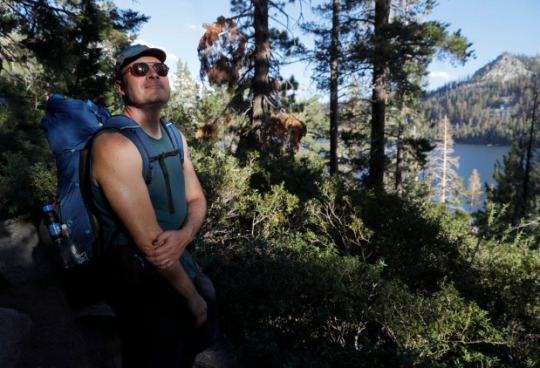
Schrock, of Long Beach, flew from Ashland, Oregon, to Fresno and then caught a bus to Yosemite to get back into the Sierra Nevada and finish his vacation covering more ground and enjoying the wilderness on his multi-year quest to complete the Pacific Crest Trail, he recalled while taking a snack break beside Lower Echo Lake near Lake Tahoe.
Dallan Clancy of Belmont, 68, finishing up a day hike 100 miles west of Sacramento at Carson Pass, said he had to cancel an overnight trip last September in the southern Sierra because the U.S. Forest Service shut access to all but one of California’s national forests over fire risks, including what the agency called “fire behavior that is beyond the norm of our experience and models such as large, quick runs in the night.” Clancy said he and four friends are aiming to do the trip this year, “unless it gets really bad.”
“We’ve always made note of escape routes, but on this trip, we actually planned our escape routes. We wanted to know the routes we could take to get out to a road,” said Jack Daro, a Southern California musician taking a break at Carson Pass during a backpacking trek to Yosemite National Park.

Hikers in years past “just went and did whatever you wanted to do wherever you wanted to go,” Wilkinson said. But 2020 marked a transformation, with the million-acre August Complex Fire, the Creek Fire northeast of Fresno that led to helicopter evacuations of hundreds of people including hikers on the John Muir Trail, and other massive blazes launching California into the age of mega-fires, Wilkinson said.
Nine of California’s 20 biggest fires since 1932 have occurred in the past three years, torching 4.1 million acres, according to Cal Fire. This year’s five biggest blazes have burned 116,000 acres, and “we’re just now getting into peak wildfire season,” Wilkinson said.
U.S. Forest Service spokeswoman Adrienne Freeman noted that fire can move much faster in today’s baked-crisp forests. “The window between OK and not OK,” Freeman said, “is becoming shorter and shorter.”
Backcountry journeyers who think seeing smoke but no flames means they’re fine may be mistaken, Wilkinson said. “Fire can move like a freight train, much faster than a person can run.”
Some hikers have dramatically changed the way they travel. Loetitia Saint-Jacques, 50, a Tahoe City veterinary technician, was on an overnight trip this month near South Lake Tahoe. Before the mega-fires, she and her companions would take long trips into deep wilderness. “We don’t go as remote now,” Saint-Jacques said. “Now it’s shorter trips. We do overnights, instead of five to eight days.”
Long-distance speed-hiker Ella Raff had multiple run-ins with wildfire and its fallout after embarking on the Pacific Crest Trail in June to walk from Mexico to Canada. Last month, the Washburn Fire in Yosemite shrouded her in smoke for two days. “I was just breathing heavy smoke 24/7. It’s not very fun,” said Raff, 29, of Portland. Farther north in California, traversing 85 miles of trail charred from last year’s nearly million-acre Dixie Fire left Raff covered in ash and dismayed by a “surreal” landscape with little animal life.

Soon after, she smelled smoke from the McKinney Fire. As she was nearing the Oregon border, authorities shut the trail ahead. More than 100 miles of the route remain closed, with the fire, which started July 29, now almost contained. Raff made her way to Portland, then to Washington to hike the trail southward from Canada.
Changing jumping-off points, routes, destinations, or timing to cope with uncertainty about fires is now routine for hikers in California. The Caldor Fire, which ravaged 220,000 acres southwest of Lake Tahoe last year from August to October, forced Truckee artist Danae Anderson, 63, to cancel three backpacking trips. “Everything was too smoky up here,” said Anderson, hiking beside Lower Echo Lake. She went to Yosemite instead.
Reckless target shooting by a father and son allegedly caused the Caldor Fire. The inferno’s scar stretches nearly 50 miles southwest of Echo Lakes in a swath up to 15 miles wide, much of it a blackened wasteland of lifeless trees, some downed, some standing without greenery, granite on many boulders shattered in places by the intense heat. More than 80 miles of the Pacific Crest Trail were closed from the fire’s start last August until early this year. Hikers passing through such areas may find water scarce, and standing dead trees can pose a deadly toppling hazard, said Matt Rump, a trail stewardship staffer for the Pacific Crest Trail Association.
Crews take down the most dangerous trees, but because there are so many dead, and they provide important wildlife habitat, officials accept some risk to hikers, under the calculus that “if you get whacked, it’s your time,” said Cheryl Bailey, 73, a volunteer for the Tahoe Rim Trail Association, as she walked along the 2 1/2 miles of the rim trail that run through the Caldor scar and that she’s been helping rebuild.
Some hikers console themselves with fire’s importance to forest health, but many of today’s blazes burn so hot they kill trees accustomed to lower-intensity fires.
In the Echo Chalet store where Schrock, who fled the McKinney Fire, bought snacks, cashier Georgia Sprague, 22, chatted with the trekkers whose ebbs and flows depend on fires and smoke. Many expressed urgency over climate change.
“They feel a lot of a push to get out,” she said, “and see the world before it burns up.”
Wildfire safety tips for hikers
Recommendations for staying safe while hiking in the age of mega-fires:
Check websites such as InciWeb for fire information and PurpleAir for air-quality information before, and if possible during, backcountry trips.
2. Give friends and family your itinerary, always know your location and pay close attention to your surroundings in case you need to retreat.
3. Know whether fires are prohibited where you’re going.
4. Carry paper maps in addition to any digital maps or apps.
5. Use cell phones and satellite-based devices to monitor weather, fires, wind, air quality and alerts such as Red Flag wildfire warnings, and to stay in close contact with people not in the wilderness who may have better access to weather and fire information. Many satellite-based messaging devices such as the popular Garmin inReach also act as rescue beacons; trekkers wishing to stay less connected may prefer personal locator beacons that are only for emergency rescue.
6. Pay attention to signs at trailheads and trail junctions.
7. Gather crowd-sourced fire and trail information from reliable websites and forums.
8. Carry an N95 mask in case of smoke.
9. Watch the sky for smoke, and use your nose to detect it.
27 notes
·
View notes
Photo
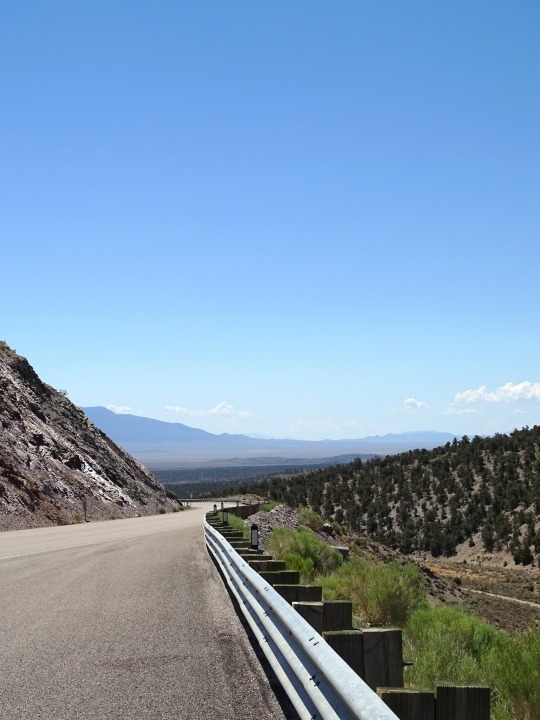



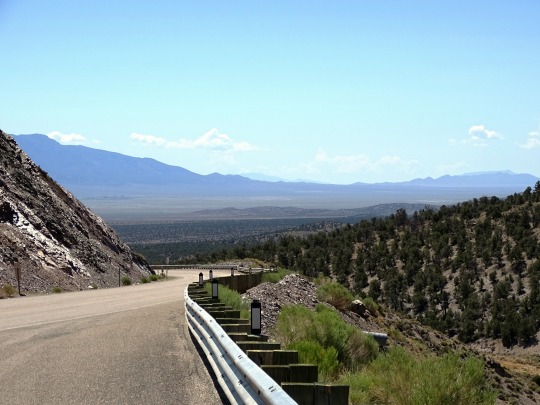





Highway 50 (No. 1)
U.S. Route 50 (US 50) is a transcontinental highway in the United States, stretching from West Sacramento, California, in the west to Ocean City, Maryland, on the east coast. The Nevada portion crosses the center of the state and was named "The Loneliest Road in America" by Life magazine in July 1986. The name was intended as a pejorative, but Nevada officials seized it as a marketing slogan. The name originates from large desolate areas traversed by the route, with few or no signs of civilization. The highway crosses several large desert valleys separated by numerous mountain ranges towering over the valley floors, in what is known as the Basin and Range province of the Great Basin.
US 50 has a diverse route through the state, traversing the resort communities of Lake Tahoe, the state capital in Carson City, historical sites such as Fort Churchill State Historic Park, petroglyphs, alpine forests, desert valleys, ghost towns, and Great Basin National Park.
The route was constructed over a historic corridor, initially used for the Pony Express and Central Overland Route and later for the Lincoln Highway. Before the formation of the U.S. Highway System, most of US 50 in Nevada was designated State Route 2. The routing east of Ely has changed significantly from the original plans. The route change resulted from a rivalry between Nevada and Utah over which transcontinental route was better to serve California-bound traffic, the Lincoln Highway or the Victory Highway.
Source: Wikipedia
#Highway 50#The Loneliest Road in America#landscape#countryside#travel#road trip#street scene#Nevada#Major Place#Millard County#US 50#US Route 50#mountains#view#original photography#summer 2022#vacation#blue sky#clouds#forest#woods#flora#nature#tourist attraction#landmark
9 notes
·
View notes
Photo
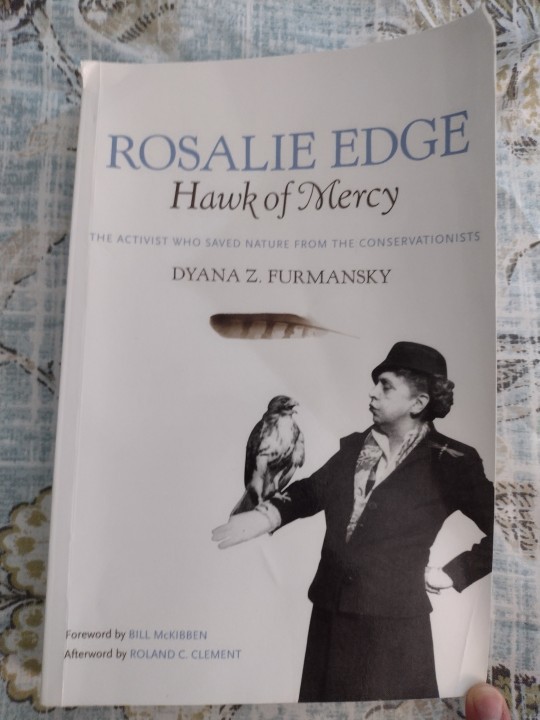
Book review: Rosalie Edge, Hawk of Mercy: The Activist Who Saved Nature From the Conservationists by Dyana Z. Furmansky
This is a biography of Mable Rosalie Edge, a former suffragette turned early conservationist. She was the daughter of John Wylie Barrow, a wealthy accountant who was the cousin of Charles Dickens. She grew up knowing the Vanderbilts, often relying on their charity because when her father died he failed to give his wife part ownership of his company, and the wealth of the family dramatically declined. She showed no particular interest in birds or nature as a child. She later traveled to Japan to marry her fiancé Charles Noel Edge, at an age older than most women of her time married. As they traversed through Asia, she appreciated some of its areas of wilderness, but again gave no indication of being a full-blown nature lover.
After years of traveling, she convinced Charles to move to New York rather than England. They bought a summer estate by the sea, and there she began to get into bird watching, and stopped hunting them with Charles. After 11 years of marriage, she then discovered that Charles had been cheating on her, and left him after he broke her arm when she confronted him about a certain letter she found. They remained legally separated for the rest of their lives. However, she was still very much in love with him, and never found anyone else.
Her work as a conservationist did not begin until she reached her 50s. She was moved by a pamphlet she received in the mail co-authored by someone named Willard Van Name, an ornithologist who became concerned with the amount of bird hunting and corruption within the Audubon Society. The Audubon Society was taking vast amounts of money from hunting groups, some of which went directly to the salary of its director, and was only interested in preserving species that could be hunted. The predators of species commonly hunted, such as bald eagles, were allowed to be ruthlessly hunted on their so-called wildlife reservations. The organization was also trapping animals like minks and selling their furs, while lying to the public about it. Van Name worked for the Museum of Natural History, and was essentially silenced when his bosses with connections to the Audubon Society threatened to fire him if he ever published something similar to the pamphlet again. With him as a mentor, Rosalie Edge took on the fight to change the Audubon Society. The Christian Science Monitor described her as, “...that peculiarly powerful being, an individual who has private means, who accepts no salary, no expenses, no gifts, and whose independent social position helps her to speak fearlessly and to act uncompromisingly.”
Some of the many things Edge accomplished over the span of 30 years were founding the Emergency Conservation Committee, creating Hawk Mountain Sanctuary, the first sanctuary formed with private funding, publishing pamphlets that exposed the corruption within various groups like the Audubon Society, U.S Forest Service, and National Parks Service, leading campaigns that led to the creation of the Olympic National Park and Sequoia-Kings Canyon National Park, persuading congress to restore big trees to Yosemite National Park after they had been illegally traded, and preventing Yellowstone Falls in Yellowstone National Park from being diverted. She also sounded early warnings against DDT and kept hawk counts that were integral to Rachel Carson’s later research, and prevented trumpeter swans from going extinct.
Her founding of the Emergency Conservation Committee was particularly significant because it never became an official legal entity; it was run by her and van Name and one other person. It had the ability to go after any controversial issues without having to deal with the conflicting interests of a large board of directors. Eventually it gained a larger mailing list than the Audubon Society, and was essential in distributing information about various conservation campaigns to the public. Almost every other nationally organized conservation body was held hostage to wealthy sportsmen, gun companies, or lumbermen. Today few people know who Rosalie Edge was, but to many in her time she was, “without question the foremost woman conservationist of the twentieth century.” Arguably the foremost conservationist of the twentieth century, period, as most of the male conservationist were at some point corrupted in one way or another.
#rosalie edge#biography#non-fiction#dyana z. furmansky#conservation#conservation movement#book#bookblr#book review
14 notes
·
View notes